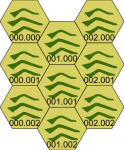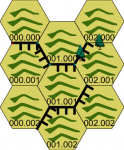This isn't going to be 100% applicable because it technically is a "octagon" map developed for the micro rather than the macro scale... more of an adventure map than a setting map... but it encapsulates a lot of how I could envision hex maps working as a tool rather than just a visual reference.
Here's the "oct map" I created for my homebrewed post-apocalypse generation ship space survival game.
Some elements of note:
The colored borders around the octagons denote what is found there and the danger it presents to the party (red is dangerous situations, purple is environmental hazard, green is a place of respite or reward, etc.). It also denotes the complications of moving between hexes (of note: my game is on a spaceship - moving horizontally along the octagons means venturing through different connected sections of the same deck, moving vertically means going up/down a deck naturally by stairs or elevators or whatever, and moving diagonally means going to a different part of the ship through an unusual route like through the air ducts or by being smuggled in or whatever - The triangles connecting diagonal areas are colored to represent the difficulty of this non-traditional approach).
The colored areas behind the octagons represent the section of the ship that these adventures take place (for instance, everything in Areas A1 through H1 takes place in a part of the ship called "Madbi"). This is perhaps another way you could encapsulate terrain or biome or whatever on a map without actually filling in anything on the hex/oct.
The contents of each octagon are meant to be rolled up and written into the octagon as a reference using tables. Red octagons have table entries like "marauder clan" or "infested with mutants", green ones have stuff like "hungry man who will owe you a favor if you feed him" or "untouched cargo bay", grey have neutral stuff, and so on. Each table applies to each area of the ship the the octagon is found within; for instance, there's a table for Red octagons in Madbi, and a different table for Red octagons in Manetube, because you'll encounter different groups and obstacles in different parts of the ship. I roll up what the octagon holds, and notate it in the octagon directly so I can reference the contents. I also pre-roll the complications that crossing through borders between octagons might have and notate them in the octagon as well.
You'll hopefully also note that the octagons are presently blank - the reference has been moved to the side of the map rather than putting "B12, B13, B14" etc into every applicable octagon. I find this less intrusive, but then again, I'm using octagons not hexagons, and I recognize that this approach doesn't work well with the staggered offsetting that hexagons have over octagons which prevents them from making neat rows/columns. Yes, octagons are harder to get an accurate sense of related scale when compared to hexagons, but I argue that the role of the map as a DM tool is better served when such exactitudes are omitted from being captured, rather than working the whole map to be a perfectly accurate scale image. I am a proponent of not catering to obsessive nitpicking on my player's part, which I find detracts from play more than it helps.
Anywhoo, I realize this is a bit like me throwing a flowchart at you when you want to design a diagram, but maybe you'll find something to appropriate.

